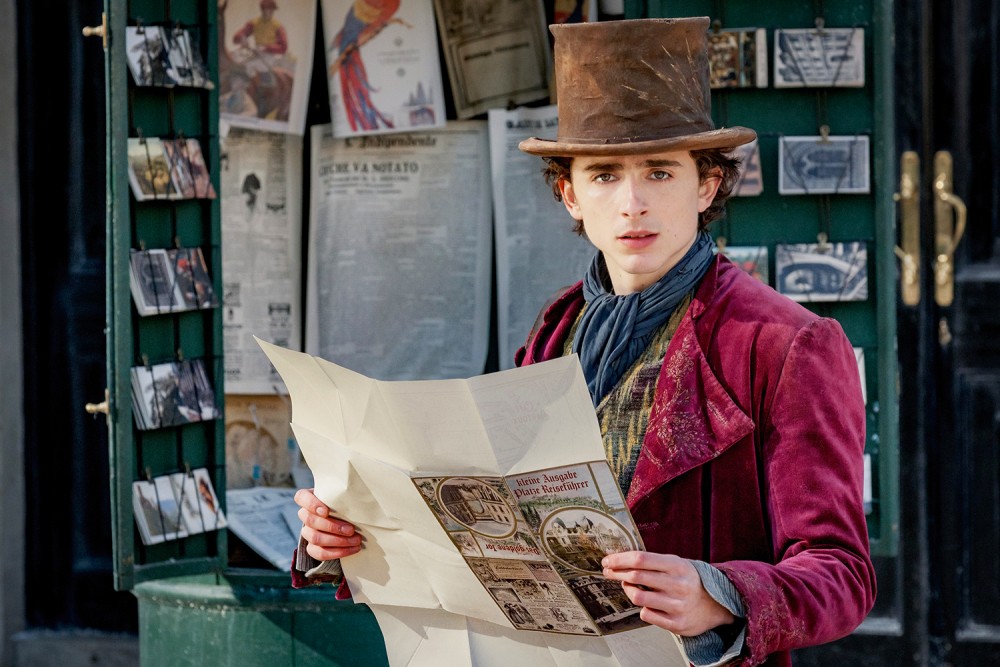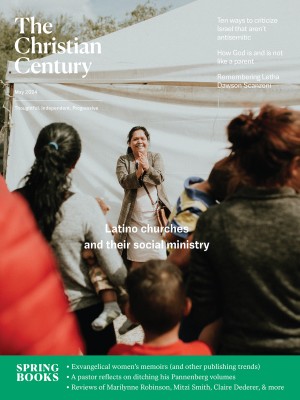A holy fool with chocolate
Understanding Wonka in light of the gospel’s message of radical, unconfined love

Timothée Chalamet as Willy Wonka in Wonka (Warner Bros.)
“Reality had little weight in his transcendence,” wrote poet A. R. Ammons, “so he / had trouble keeping / his feet on the ground.” I couldn’t help but think of these lines from “He Held Radical Light” as I watched Wonka, a musical origin story of the self-described “magician, inventor, and chocolate maker” Willy Wonka.
Portrayed with levity by Timothée Chalamet, this fresh-faced incarnation of Roald Dahl’s eccentric character arrives in an unnamed European city (a storybook blend of London, Paris, and Prague) after seven years of globe-spanning research. With only a suitcase-sized chocolate apothecary to his name, he’s eager to make his fortune. “It’s time to show the world my recipes,” he sings in “A Hatful of Dreams.”
Read our latest issue or browse back issues.
Of course, it’s not quite that easy. His hurdles include being swindled into Dickensian indentured servitude by Mrs. Scrubitt. But his buoyancy remains unballasted as he twirls around lampposts, floats above rooftops on a bundle of balloons, and peddles “hoverchocs” that bestow temporary levitation.
Wonka, directed by Paul King of the Paddington movies, is billed as a prequel to the 1971 film Willy Wonka and the Chocolate Factory, starring Gene Wilder in his most iconic turn. Chalamet’s Wonka, though, bears only passing resemblance to either the strange little man of Dahl’s Charlie and the Chocolate Factory or to his previous cinematic personae, including Wilder’s beloved but sardonic interpretation and Johnny Depp’s controversially disturbed 2005 turn.
All three of those stories’ confectionary antics can feel like cruel pranks in a retributive moral system. By contrast, this Wonka’s refreshingly playful and generous spirit is precisely what makes his magic seem at once entirely intrinsic and a wondrous, infectious gift—if wrapped in a zany and sometimes naive box. Willy’s friend Noodle remarks in their poignant duet that because “for a moment, / Life doesn’t seem quite so bad,” she “can’t keep [her] feet on the ground”—figuratively and literally.
The ancient Christian archetype of the holy fool offers a framework to interpret Wonka in light of the gospel’s message of radical, unconfined love. Holy fools derive their name from St. Paul’s exhortation in the first letter to the Corinthians: “If you think that you are wise in this age, you should become fools so that you may become wise” (3:18). They cut against the grain of social norms with their eccentric and often highly ascetic behavior, revealing truth through folly in the face of ridicule. “The holy fool acts so as to question the boundary between what is sacred and what is profane,” writes Jesse Perillo in the Journal of the Society of Christian Ethics, “and to question whether common secular or religious conventions are truly sane practices.”
In performing public acts of disruption such as eating meat on fast days, extinguishing candles before mass, or living atop pillars for years, figures such as St. Simeon Salos, St. Francis, and St. Simeon the Stylite pointed toward Christianity’s original holy fool, Jesus himself. The carpenter from Nazareth actively contravenes the religious law and social expectations of his time—healing on the sabbath, overturning tables in the temple, breaking bread with sinners—to demonstrate the foolish wisdom of unconditional compassion. In Ammons’s rendering, Jesus does so because “he held radical light / as music in his skull.”
With the music in his head spilling into the world, the illiterate Willy follows a similar pattern of holy folly. He disembarks the steamboat in song: “Got a tattered overcoat and battered suitcase. / Got a pair of leaky boots upon my feet. . . . / I've poured еverything I've got into my chocolate.” (Chalamet’s singing and dancing are no match for, say, Hugh Jackman’s, but anything more polished would have contradicted the character’s rustic dignity.) His vocation, we learn, was inherited from his mother, who saved up her meager wages to make delicious chocolate once a year on their modest but cozy houseboat. She has since died, but the dreams she nurtured in him live on.
As Willy begins his own humble ministry, sharing hoverchocs in the Galéries Gourmet, the city’s temple of cuisine, his unorthodox style is promptly targeted by a cartel of chocolate magnates in cahoots with a corrupt police chief and a chocoholic cleric. Willy’s very being, unironically exuberant and offbeat, challenges the bourgeois-capitalist state- and church-sponsored status quo, to the extent that the villains employ violence in their efforts to quash him.
In response to these oppressive forces of authority, Willy displays persistent whimsy, self-giving, and an ability to draw others together in fellowship. He forms his own alliance with the orphan Noodle and a motley crew of Mrs. Scrubitt’s other victims; together they embark on a guerrilla campaign to spread chocolaty delight, eluding their pursuers with ingenuity and cooperation. When their luck tragically runs out, Willy sacrifices his own ambitions to secure his friends’ freedom, nearly meeting his end in the process. Expressing that age-old mythical paradigm, he symbolically descends into hell in order to be reborn and transform a weary world.
That world is run by the rich and powerful. Most of the antagonists—even the proletarian Mrs. Scrubitt—express an explicit disdain for those of lower estate, but Willy’s kindness disregards boundaries of race and class. In a telling vignette, cartel leader Mr. Slugworth can’t even remember the name of his dead brother’s wife, a once-poor woman who turns out to be Noodle’s long-lost mother; Willy, whom Noodle has been teaching to read, uses his nascent skills to identify “Dorothy” on a slip of paper, thereby helping to reunite the pair.
To its detriment, the film does not always share Willy’s heart. It unsettlingly retains Dahl’s fat phobia, resorting to broad comedy at the increasingly overweight police chief’s expense. The tropically indigenous Oompa-Loompas are preserved in their orange-skinned, green-haired form from the 1971 film without unpacking the problematic racist, colonialist tropes therein. Violence, though mostly perpetrated by the bad guys, is employed all too casually and even made the subject of humor.
These ethical shortcomings notwithstanding, it is the noble spirit of Willy himself that shines through on balance. The church might take a cue from his holy absurdity in seeking to live the gospel beyond its walls.
The film’s climax includes a giraffe, flamingos, and a chocolate fountain erupting as people join in cocoa-warmed communion. In a true priestly gesture, Willy’s generosity is counterpoised against the cleric’s earlier refusal to give Noodle any chocolate. Chocolate is shown to be sacramental, enabling the restoration of relationship (no fewer than two couples are joined in matrimony thanks to Willy’s sweets) but corrupting if clasped too tightly. “There’s chocolate, and there’s chocolate,” one of the film’s musical refrains goes. Where the cartel’s chocolate is hoarded and twisted as a medium of control and dependence, Willy’s is broken and poured out for all.
Holy fools “encompass the understanding of the holy that is dangerous because it is incapable of being bound,” Perillo contends. Might we, as the body of Christ, reclaim the way of the fool? Could those of us in liturgical traditions, wary of emotionalism as we often are, for a moment believe that Jesus could truly, personally love us?
“Come with me, and you’ll be / In a world of pure imagination,” Willy invites us in Wonka’s reprise of the 1971 film’s most memorable number. “Don’t be shy, it’s all right / If you feel a little trepidation,” he assures. But let’s not allow our familiar customs—even one as beautiful as the Eucharist, which in Roman Catholicism is technically “confected” by the priest—to lull us into sacramental complacency or deter us from loving playfully, widely, and even foolishly.
____
I am grateful to Rita Powell for being an integral conversation partner and editor in the process of writing this article.






